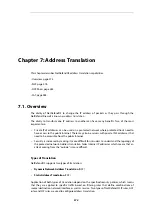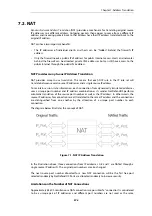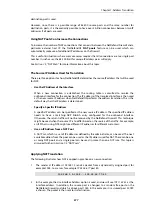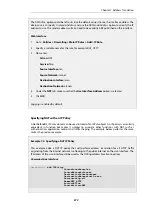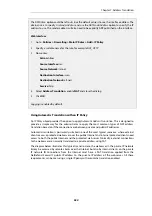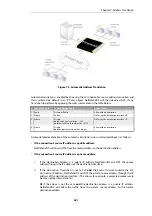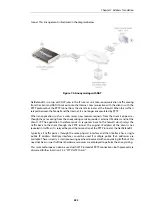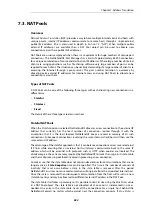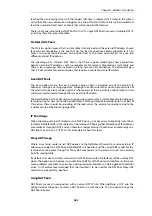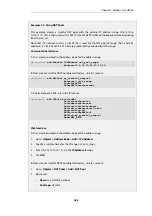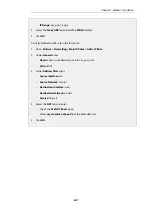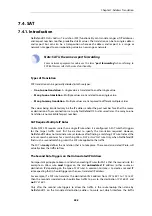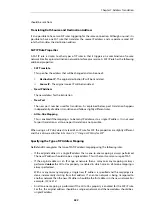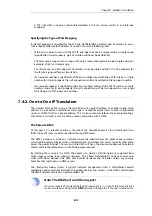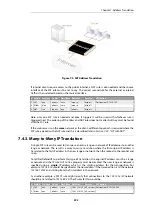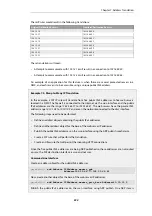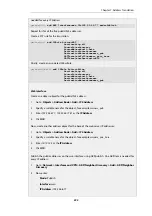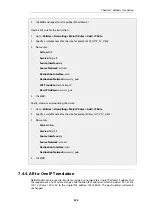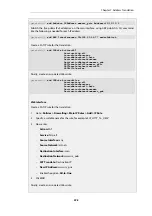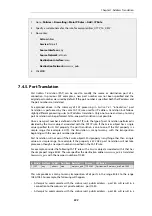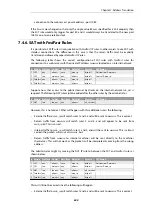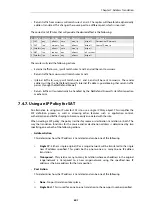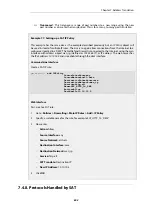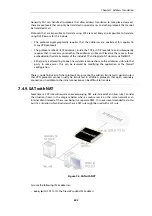
7.4. SAT
7.4.1. Introduction
NetDefendOS
Static Address Translation
(SAT) functionality can translate ranges of IP addresses
and/or port numbers to other, predefined static values. The translation can be to a single address
and/or port but can also be a transposition where each address and/or port in a range or
network is mapped to a corresponding value in a new range or network.
Note: SAT is the same as port forwarding
Some network equipment vendors use the term "
port forwarding
" when referring to
SAT. Both terms refer to the same functionality.
Types of Translation
SAT translation can be generally divided into three types:
•
One-to-one translation - A single value is translated to another single value.
•
Many-to-one translation - Multiple values are translated to one single value.
•
Many-to-many translation - Multiple values are transposed to different multiple values.
The values being translated may be the IP address and/or the port number for either the source
or destination of new connections set up by NetDefendOS. As discussed later, the many-to-one
translation is not available for port numbers.
SAT Requires Multiple IP Rules
Unlike NAT, SAT requires more than a single IP rule when it is configured. A
SAT
rule that triggers
for the target traffic must first be created to specify the translation required. However,
NetDefendOS does not terminate rule set lookups after finding a matching
SAT
rule. Instead, the
rule set search continues for a matching
Allow
,
NAT
or
FwdFast
rule. Only when NetDefendOS
finds such a second matching rule is the
SAT
rule applied to the traffic.
The
SAT
rule only defines the translation that is to take place. The second, associated IP rule, will
actually allow the traffic to flow.
The Second Rule Triggers on the Untranslated IP Address
An important principle to keep in mind when creating IP rules for SAT is that the second rule, for
example an
Allow
rule, must trigger on the old, untranslated IP address (either source or
destination IP depending on the type of
SAT
rule). A common mistake is to create a second IP
rule expecting that it should trigger on the new, translated IP address.
For example, if a
SAT
rule translates the destination IPv4 address from
192.168.0.1
to
172.16.0.1
then the second associated rule should allow traffic to pass to the destination
192.168.0.1
and
not
172.16.0.1
.
Only after the second rule triggers to allow the traffic, is the route lookup then done by
NetDefendOS on the translated destination address to work out which interface the traffic
Chapter 7: Address Translation
588
Summary of Contents for NetDefendOS
Page 30: ...Figure 1 3 Packet Flow Schematic Part III Chapter 1 NetDefendOS Overview 30 ...
Page 32: ...Chapter 1 NetDefendOS Overview 32 ...
Page 144: ...Chapter 2 Management and Maintenance 144 ...
Page 284: ...Chapter 3 Fundamentals 284 ...
Page 392: ...Chapter 4 Routing 392 ...
Page 419: ... Host 2001 DB8 1 MAC 00 90 12 13 14 15 5 Click OK Chapter 5 DHCP Services 419 ...
Page 420: ...Chapter 5 DHCP Services 420 ...
Page 573: ...Chapter 6 Security Mechanisms 573 ...
Page 607: ...Chapter 7 Address Translation 607 ...
Page 666: ...Chapter 8 User Authentication 666 ...
Page 775: ...Chapter 9 VPN 775 ...
Page 819: ...Chapter 10 Traffic Management 819 ...
Page 842: ...Chapter 11 High Availability 842 ...
Page 866: ...Default Enabled Chapter 13 Advanced Settings 866 ...
Page 879: ...Chapter 13 Advanced Settings 879 ...

